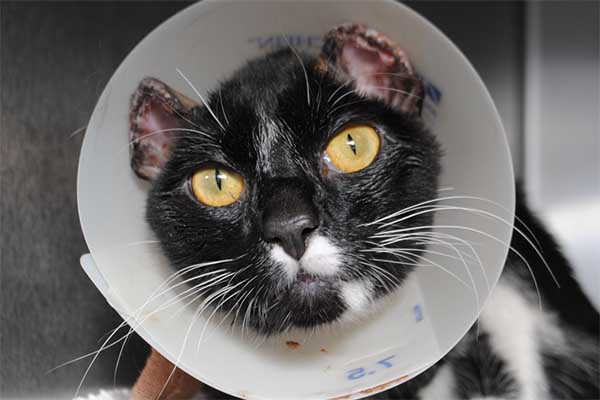PAWS Treats Frostbitten Cat
Feb 22, 2016
Winter weather can be dangerous for both family pets and homeless animals.

Dogs and cats are vulnerable to hypothermia (low body temperature) and frostbite (frozen body parts) when exposed to cold temperatures for too long.
One of PAWS Chicago's adoptable cats, Hawking, had to be treated for frostbite on both of his ears when he was rescued earlier this month. Two-year-old Hawking had been found outside a school in the Portage Park community, dehydrated and weighing less than six pounds.
When he was brought to Chicago Animal Care & Control (CACC), the city pound, Hawking was “extremely emaciated and in so much pain he wouldn’t allow anyone to touch him. After they got some food in his belly he became affectionate and they were able to start his treatment, which involved feeding and treating his ears with antibiotic cream,” says Stacy Price, Director of Animal Operations for PAWS Chicago.
Hawking was transferred from the pound to the PAWS Chicago Medical Center in Little Village for more treatment. He is now a healthy and happy indoor cat who will never again have to survive outside in Chicago's cold weather. Learn more about adopting Hawking and meet all of our available dogs and cats >>
Keeping Pets Safe in Cold Weather
Prevention is key to keeping family pets safe during cold Chicago winters. The amount of time a dog spends outside should be limited and pets should never be left alone in a car.
Signs of hypothermia in pets include violent shivering, muscle stiffness, lethargy, problems breathing, weak pulse or lack of appetite. If you suspect pets are suffering from hypothermia, you should contact your veterinarian immediately. Animals also should be wrapped in a warm blanket or coat or brought into a warm room. Hair dryers, heating pads and electric blankets should not be used to warm up a hypothermic pet as this may result in burns or compromised circulation to vital organs.
Frostbite usually appears first in an animal’s extremities. Cats’ paws, tail and ears are most vulnerable. Dogs tend to get frostbite on their ears, footpads and scrotum. An animal’s skin may appear pale, gray or blue at first and then become red, puffy or shriveled. If you suspect frostbite, contact your veterinarian immediately. You can also gently warm the frostbitten areas by immersing them in warm (not hot) water or cover them with warm, moist towels for at least 20 minutes. Never rub or massage affected areas as this will worsen the damage, and avoid using dryers, heating pads or electric blankets.
Find more tips for keeping your pets safe in cold weather >>
